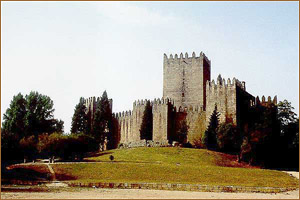|
|
|
|
|
Introduction:
Guimarães
|

^
The Guimarães castle: "the place where Portugal was
born". |
With 160,000 inhabitants, Guimarães is Portugal’s second largest urban centre in terms of populous (without taking into account Lisbon and Porto metropolis) and offers a balance between country and city life.
Guimarães is located in the Ave valley. Because there are a number of communities across the Baixo Minho region, it has to compete with other urban centres to establish itself as one of Portugal’s premier cities. Many are also dependent on the land for their living, with an agricultural way of life holding popular appeal.
However, Guimarães has benefited
|
from this city and countryside contrast and has made great strides forwards. Its unique compromise between urban and rural living has clear appeal when compared to the high density living of bigger cities. “A city to the human scale,” is a phrase that has stuck in describing its appeal and it has become its trademark.
For nearly a decade, a regeneration plan helped transform Guimarães’s historic centre leading to its inclusion in the UNESCO World Heritage List in 2001. The work was handled sensitively with information sessions being held to fully brief locals on what was being done. This regeneration turned a previously run-down area into the crown jewel of the region. Visitors can now enjoy a group of buildings that capture their respective historical periods, many of which are used as homes. The area provides plenty of entertainment and opportunities for cultural understanding. The historic centre regeneration, meticulously planned with careful attention to detail, was the first step towards the city’s new beginning.
Another element in establishing the city has been the basing in Guimarães of various departments of the Minho University. These include the schools of engineering and architecture in addition to the social sciences unit. These have helped attract young people to the area and stimulated cultural activities, which is reflected in the large number of managers and board members from public and private institutions that have flocked to the area, despite the obvious competition from nearby Braga and Porto.
All these have aspects have led to a boom in the property market, unprecedented in the city’s contemporary history. In the next two years, Guimarães will also see the completion of several road projects. These include the conclusion of the road connection between A11 and IP9 (linking it with Braga and the west) and the connection between A7 and IC5 (to the interior and to Spain). Adding to that, improvement work to the local railroad network is also set to be ready.
With a priority on widening the range of employment on offer, Guimarães wants to highlight its standing in the north-western Iberian peninsula and become an attractive option to those who want to live and work in a city with quality of life.
|
|
|
|
|
|
Stadium:
Estádio Afonso D. Henriques
|

^
The stadium's capacity has been boosted to 30,000. |
Capacity 30,000
Entity
Vitória Sport Clube
Architect
Eduardo Guimarães
This stadium is located in the centre of the city known as the 'birthplace of the nation'. Its four stands have been completely remodelled and expanded, increasing the stadium's total capacity to 30,000. This is the new home of Vitória SC, founded by students from Guimarães in the 1920s, children of the industrial and entrepreneurial society that predominated in the city at the time.
When Guimarães was chosen as one of the venues for EURO 2004, the
|
City Council had two options: building a new stadium from scratch on council land or rebuilding the Estádio Afonso D. Henriques, in the centre of the city. As the old town
has been considered a world heritage site by UNESCO, the council decided to revamp the whole area.
As the stadium is in one of the most beautiful areas of the city, near Portugal's most famous castle, the whole project had to consider the architectural harmony of both the exterior and the interior. It is located in the garden around the castle and, at first sight, few people realise that they are looking at a football stadium at all.
The tournament director, António Laranjo, has said that it is a remarkable piece of work. "Visitors will be thrilled to be able to go into a stadium, look around them and enjoy the view. There is a very good harmony between the interior and exterior."
Estádio Afonso D. Henriques was inaugurated on 25 July. The spectators, who practically filled the new stands, watched a multimedia show followed by a match between Guimarães and 1. FC Kaiserslautern, which the home team won 4-1.
|
|
|
|
|
|
 |
Average highest temperature in June:
n/a |
|
|
|
|
C
Denmark
v Italy
1800 CET 14 June 2004
C
Italy v Bulgaria
2045 CET 22 June 2004
|
|
|
|
|
|
|



